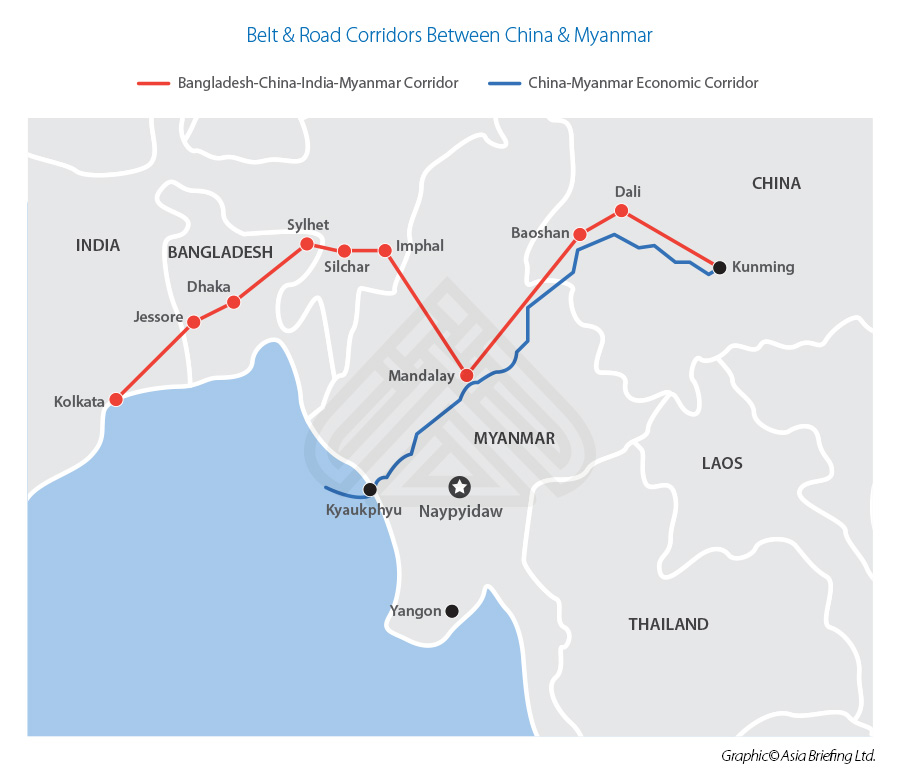Belt And Road Projects In Myanmar Likely To Progress In Light Of Military Coup
Op/Ed by Chris Devonshire-Ellis
Belt and Road projects in Myanmar can now be expected to proceed rather more smoothly than has been the recent case following the Military take-over of the country on Monday. The Commander-In-Chief, General Min Aung Hlaing, who is now in charge of the country has longstanding connections with Chinese President Xi Jinping, and it is unlikely the coup went ahead without Beijing being informed. China has previously provided military support to the Burmese Army in uprising in Kachin State, which borders China’s Yunnan Province.
The China Myanmar Economic Corridor
China is looking to develop the China-Myanmar Economic Corridor, which connects China through to the Bay of Bengal and Myanmar oil and gas fields there. It extends from Ruili in Yunnan Province, runs through through Muse and Mandalay to Khyaukphyu in Myanmar’s Rakhine State, and follows gas and oil pipelines built in 2013 and 2017. At the Myanmar end of the route, a port and Special Economic Zone is planned at Khaukphyu. We highlighted the development of the Khaukphyu SEZ in this article. The link to Kyaukphyu is important for Beijing as it allows China to quickly bring oil and gas, as well as regionally produced and less expensive goods and resources, into the country overland, bypassing the sea route through the Straits of Malacca. The pipelines, which are already operational, are owned by China National Petroleum Corporation (CNPC) and Myanmar Oil and Gas Enterprise (MOGE), both large state-owned companies.
The largest construction project along the route is the 431 km Muse-Mandalay Railway, with costs estimated at U$9 billion. This would connect Myanmar to the Chinese railway network. An important part of the corridor will be three core zones at the border of both countries. The core zones will be commercial areas with duty-free concessions, hotels, manufacturing, and financial services. According to a policy plan released in 2019 by the Myanmar Ministry of Commerce, the locations for the core zones would be Muse and Chinshewehaw in the northern part of Shan State and Kan Pite Tee in Kachin State.

The Bangladesh-China-India-Myanmar Corridor
The Bangladesh, China, India and Myanmar Economic Corridor (BCIM) is a proposed route connecting India and China through Myanmar and Bangladesh. It has faced partial opposition from India, although the feasibility of the project has been welcomed in some quarters as India’s somewhat isolated eastern and north-eastern states would stand to gain by higher trade and connectivity with China and the rest of Asia.
It was not included in the 2019 list of Belt & Road projects announced at the second Belt & Road Forum, however later that year India sent a delegation to the 13th BCIM Forum in Yuxi, noting however the corridor predates the BRI. If agreement can be reached, the BCIM corridor will cover 1.65 million sq km, connecting an estimated 440 million people in China’s Yunnan province, Bangladesh, Myanmar, and India’s West Bengal State through a combination of road, rail, water and air links in the region. The BCIM envisages greater market access for goods, services and energy, elimination of non-tariff barriers, better trade facilitation, investment in infrastructure development, and joint exploration and development of mineral, water, and other natural resources. There are some linguistic oppositions to overcome, as India will not recognise any projects listed as part of China’s Belt & Road Initiative as the China-Pakistan Economic Corridor (CPEC) runs through parts of China and Pakistan that India claims as its territory. If consensus can be reached that the BCIM corridor is not part of the Belt & Road project, then it makes Indian political acceptance of it easier.
Were it to be given the green light, the economic advantages of the BCIM corridor would be considerable, including access to markets in ASEAN and Southeast Asia, the improvement of transportation infrastructure and creation of Special economic, manufacturing and export industrial focused trade zones.
This would lead to industrial transfer, boosting industries such as processing, manufacturing and logistics. Also, as labour costs rise in China, labour-intensive industries such as textile and agriculture processing are being shifted out of China, most notably to Bangladesh, although Myanmar is also expected to attract this industry as a member of ASEAN and its participation of the recent RCEP free trade agreement which also includes higher production cost nations sch as Australia, Japan and South Korea. This could also have a knock-on effect for West Bengal and its 91 million population.
These industries will need to be transferred to new regions with lower labour costs. Companies operating in China and the wealthier members of RCEP would give priority to the trade corridor region given its established infrastructure, improved logistics and ease of access.
The Myanmar military, including General Min Aung Hlaing and his family, already have significant holdings in companies involved with Myanmar energy, construction and finance and are unlikely to want to see Myanmar’s participation in the Belt and Road Initiative impeded. The previous Government appeared at times beset by Minister’s personal issues getting in the way of planned developments. Myanmar’s military, with its stronger connections to big business and to China, is unlikely to allow that to get in the way.
Related Reading
About Us
Silk Road Briefing is written by Dezan Shira & Associates. The firm has 28 offices throughout Asia, and assists foreign investors into the region. For strategic advisory and business intelligence issues please contact the firm at silkroad@dezshira.com or visit www.dezshira.com





